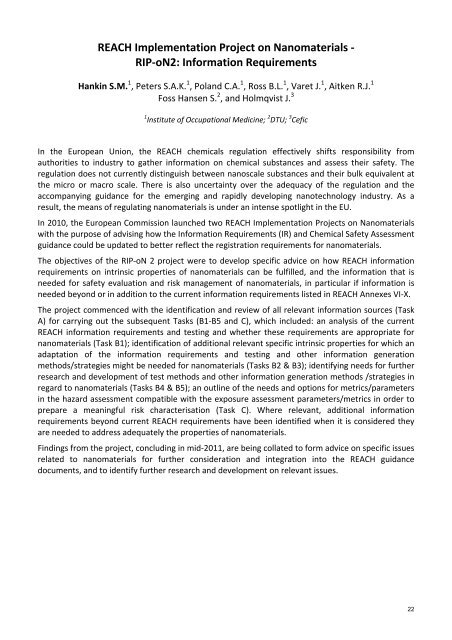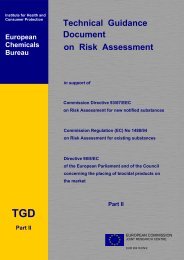Challenges of Regulation and Risk Assessment of Nanomaterials
Challenges of Regulation and Risk Assessment of Nanomaterials
Challenges of Regulation and Risk Assessment of Nanomaterials
Create successful ePaper yourself
Turn your PDF publications into a flip-book with our unique Google optimized e-Paper software.
REACH Implementation Project on <strong>Nanomaterials</strong> -<br />
RIP-oN2: Information Requirements<br />
Hankin S.M. 1 , Peters S.A.K. 1 , Pol<strong>and</strong> C.A. 1 , Ross B.L. 1 , Varet J. 1 , Aitken R.J. 1<br />
Foss Hansen S. 2 , <strong>and</strong> Holmqvist J. 3<br />
1 Institute <strong>of</strong> Occupational Medicine; 2 DTU; 3 Cefic<br />
In the European Union, the REACH chemicals regulation effectively shifts responsibility from<br />
authorities to industry to gather information on chemical substances <strong>and</strong> assess their safety. The<br />
regulation does not currently distinguish between nanoscale substances <strong>and</strong> their bulk equivalent at<br />
the micro or macro scale. There is also uncertainty over the adequacy <strong>of</strong> the regulation <strong>and</strong> the<br />
accompanying guidance for the emerging <strong>and</strong> rapidly developing nanotechnology industry. As a<br />
result, the means <strong>of</strong> regulating nanomaterials is under an intense spotlight in the EU.<br />
In 2010, the European Commission launched two REACH Implementation Projects on <strong>Nanomaterials</strong><br />
with the purpose <strong>of</strong> advising how the Information Requirements (IR) <strong>and</strong> Chemical Safety <strong>Assessment</strong><br />
guidance could be updated to better reflect the registration requirements for nanomaterials.<br />
The objectives <strong>of</strong> the RIP-oN 2 project were to develop specific advice on how REACH information<br />
requirements on intrinsic properties <strong>of</strong> nanomaterials can be fulfilled, <strong>and</strong> the information that is<br />
needed for safety evaluation <strong>and</strong> risk management <strong>of</strong> nanomaterials, in particular if information is<br />
needed beyond or in addition to the current information requirements listed in REACH Annexes VI-X.<br />
The project commenced with the identification <strong>and</strong> review <strong>of</strong> all relevant information sources (Task<br />
A) for carrying out the subsequent Tasks (B1-B5 <strong>and</strong> C), which included: an analysis <strong>of</strong> the current<br />
REACH information requirements <strong>and</strong> testing <strong>and</strong> whether these requirements are appropriate for<br />
nanomaterials (Task B1); identification <strong>of</strong> additional relevant specific intrinsic properties for which an<br />
adaptation <strong>of</strong> the information requirements <strong>and</strong> testing <strong>and</strong> other information generation<br />
methods/strategies might be needed for nanomaterials (Tasks B2 & B3); identifying needs for further<br />
research <strong>and</strong> development <strong>of</strong> test methods <strong>and</strong> other information generation methods /strategies in<br />
regard to nanomaterials (Tasks B4 & B5); an outline <strong>of</strong> the needs <strong>and</strong> options for metrics/parameters<br />
in the hazard assessment compatible with the exposure assessment parameters/metrics in order to<br />
prepare a meaningful risk characterisation (Task C). Where relevant, additional information<br />
requirements beyond current REACH requirements have been identified when it is considered they<br />
are needed to address adequately the properties <strong>of</strong> nanomaterials.<br />
Findings from the project, concluding in mid-2011, are being collated to form advice on specific issues<br />
related to nanomaterials for further consideration <strong>and</strong> integration into the REACH guidance<br />
documents, <strong>and</strong> to identify further research <strong>and</strong> development on relevant issues.<br />
22








